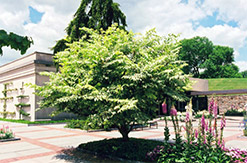Variegated Japanese Angelica Tree
Aralia elata 'Variegata'
Height: 20 feet
Spread: 30 feet
Sunlight:
![]()
![]()
Hardiness Zone: 5
Description:
A beautiful small tree with large variegated leaves and showy white flowers in summer, sharp spines on the branches; adds a tropical feel to the landscape
Ornamental Features
Variegated Japanese Angelica Tree has attractive white-variegated green foliage on a tree with a spreading habit of growth. The enormous serrated pointy bipinnately compound leaves are highly ornamental and turn yellow in fall. It features airy panicles of creamy white flowers at the ends of the branches from mid to late spring. The pink fruits are carried on plumes from early to late fall. The spiny khaki (brownish-green) bark is extremely showy and adds significant winter interest.
Landscape Attributes
Variegated Japanese Angelica Tree is a dense multi-stemmed deciduous tree with a ground-hugging habit of growth. Its relatively fine texture sets it apart from other landscape plants with less refined foliage.
This is a high maintenance tree that will require regular care and upkeep, and is best pruned in late winter once the threat of extreme cold has passed. It is a good choice for attracting birds to your yard. Gardeners should be aware of the following characteristic(s) that may warrant special consideration;
- Suckering
- Spiny
Variegated Japanese Angelica Tree is recommended for the following landscape applications;
- Accent
- Vertical Accent
- Mass Planting
- General Garden Use
- Naturalizing And Woodland Gardens
Planting & Growing
Variegated Japanese Angelica Tree will grow to be about 20 feet tall at maturity, with a spread of 30 feet. It has a low canopy with a typical clearance of 2 feet from the ground, and is suitable for planting under power lines. It grows at a slow rate, and under ideal conditions can be expected to live for 40 years or more.
This tree does best in full sun to partial shade. It is very adaptable to both dry and moist locations, and should do just fine under average home landscape conditions. It is not particular as to soil type or pH. It is highly tolerant of urban pollution and will even thrive in inner city environments. This is a selected variety of a species not originally from North America.
